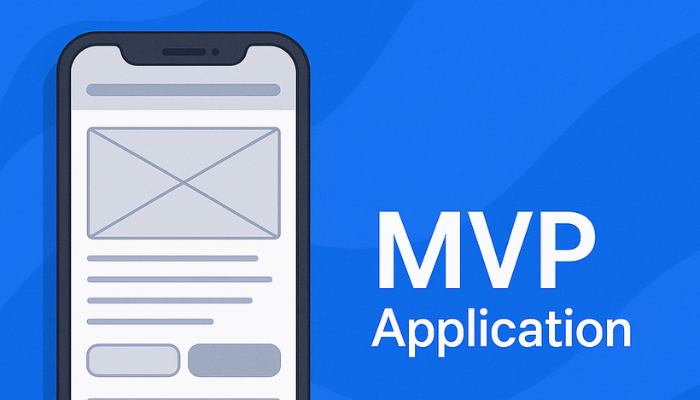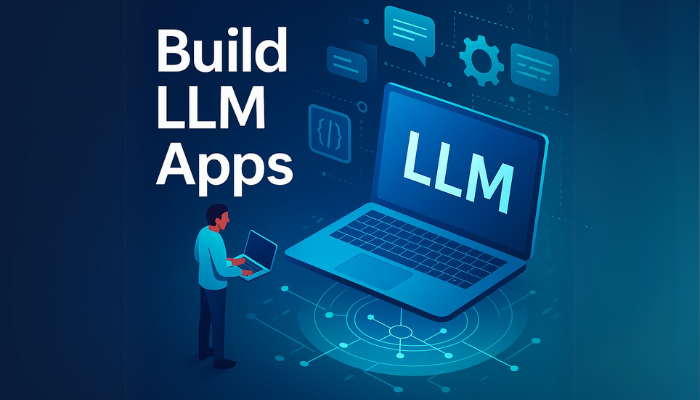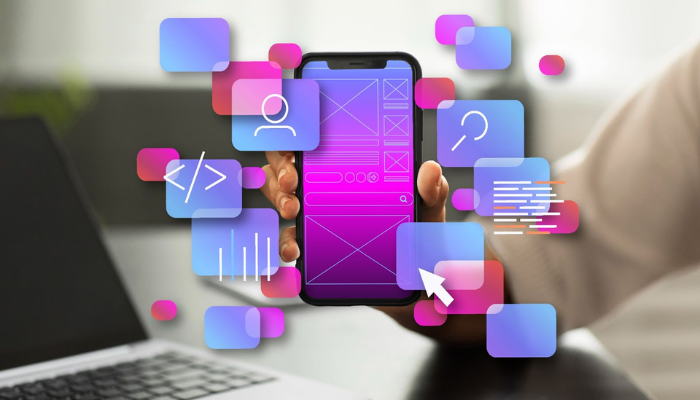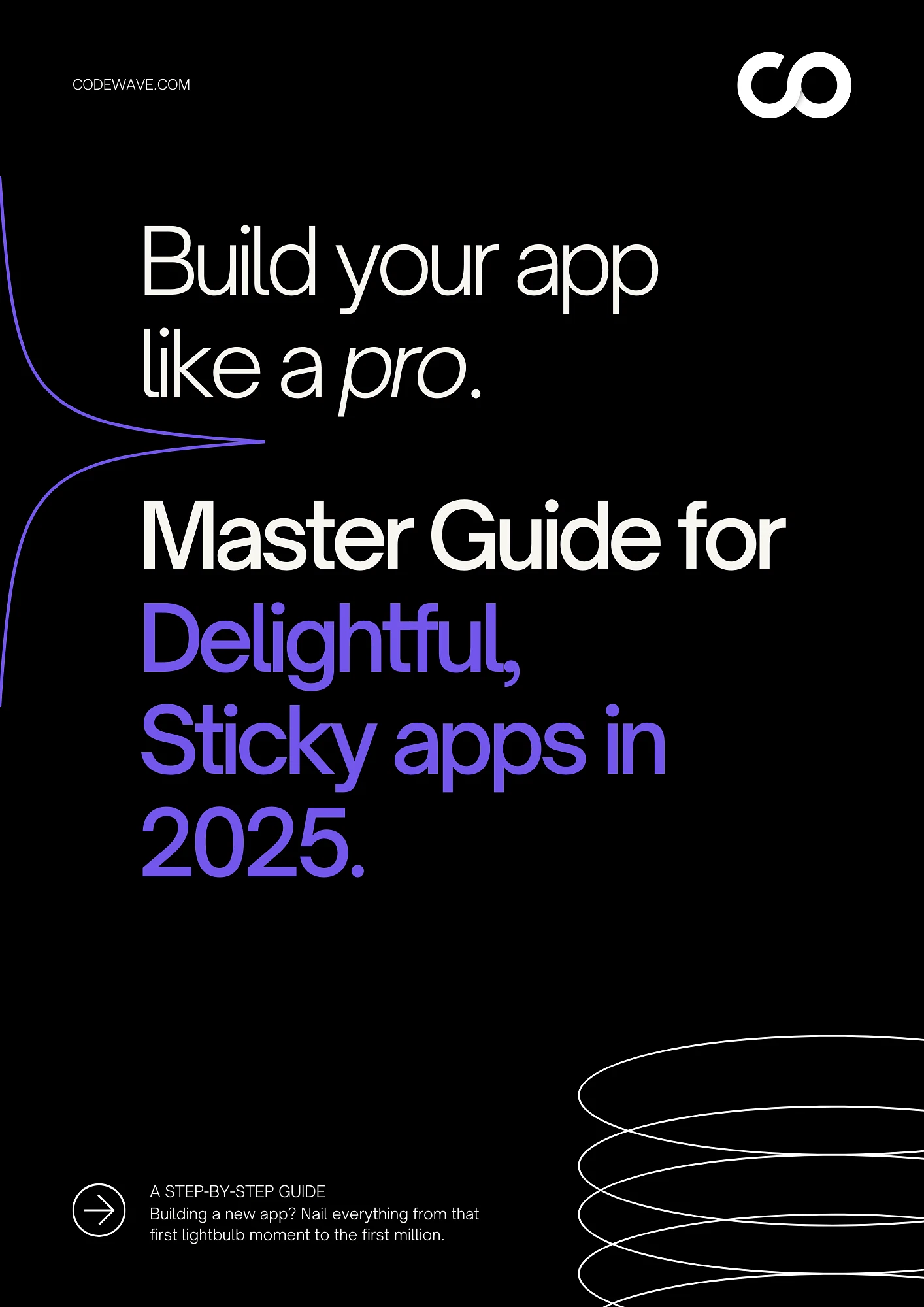Every successful app you see today, whether it’s Uber, Airbnb, or Instagram, once started as a minimal version of what it is now. That early version, known as a Minimum Viable Product (MVP), wasn’t polished or packed with features. It was built to learn. At its core, an MVP application helps you put your idea in front of real users, fast, so you can understand what works, what doesn’t, and what’s worth building next.
The shift toward building lean isn’t just a trend; it’s a strategy grounded in results. A lean approach helps you validate demand, reduce rework, and build only what’s needed. With limited time, budgets, and user attention spans, businesses can’t afford to guess. According to a 2024 GoodFirms survey, 91.3% of companies now launch with an MVP model to cut time-to-market and avoid investing in the wrong features.
This blog is your step-by-step guide to building an MVP application for mobile, from idea to launch. If you’re looking for a structured, lean, and result-oriented path to product development, you’re in the right place. Let’s break it down.
Understanding MVPs in Mobile App Development
Building a mobile app is a significant investment, and launching a fully-featured product without testing the market can lead to wasted resources and missed opportunities. That’s where the Minimum Viable Product (MVP) approach comes in. An MVP application is a streamlined version of your app that includes only the essential features needed to solve your core problem. This approach allows you to validate your business idea quickly and cost-effectively.
For executives, understanding the strategic advantages of MVP development is critical:
- Scope and Speed: MVPs focus on a single platform and the core functionalities. This reduces development time significantly compared to full-scale apps, allowing faster market entry and quicker learning cycles.
- Resource Efficiency: By prioritizing essential features, MVP development minimizes unnecessary spending on complex functions that may not be valued by users.
- User-Centered Feedback: Launching an MVP enables you to gather real user insights early, ensuring that future development aligns with actual market demand rather than assumptions.
A notable example is Spotify. Their initial MVP was a basic desktop app that offered music streaming with limited features. This simple version allowed Spotify to validate user interest and adapt quickly before expanding into the comprehensive platform they operate today.
In summary, MVP application development helps decision-makers balance risk and investment, making it a strategic tool for achieving faster ROI and operational clarity while delivering measurable business value.
Also read: A deeper look into MVP software success stories and strategies. Explore here.
Step-by-Step Guide to Building an MVP Mobile App
If you’re launching a mobile app, your MVP must prove value fast. Here’s a practical step-by-step playbook to minimize risk.
1. Identify the Business Problem and Target Audience
The first and most critical step in building an MVP application is defining the exact business problem you’re solving and who you’re solving it for. Without a validated problem statement and a clearly defined user base, your MVP will likely miss the mark, no matter how polished the product looks.
Here’s what you need to do:
Start with a pressing business goal: Are you trying to reduce customer support load, speed up onboarding, digitize a manual process, or enter a new market? Be specific. Frame this as a quantifiable challenge, for example, “Reduce lead conversion time from 14 days to 5.”
Talk to stakeholders and customers: Don’t rely on assumptions. Interview internal teams, power users, and prospects to understand pain points. Use this insight to identify what functionality is absolutely necessary and what’s not.
Document a clear problem-solution hypothesis: Clearly define the problem you’re solving and how your MVP addresses it. This sharpens focus from Day 1 and aligns your team. For instance, reducing manual reporting delays through offline data capture can improve field efficiency.
Define the target user with precision: Are they internal employees, SMB owners, Gen Z consumers? Know their digital habits, what devices they use, and what frustrations they face. This impacts UX, tech stack, and feature prioritization.
Link to business outcomes: For CFOs and CTOs, the MVP must deliver early signs of ROI. Whether it’s improved operational efficiency or better data visibility, tie the MVP scope to a measurable business impact.
Every next step in your MVP app development will be shaped by this foundation.
2. Determine Core Features to Maximize Business Value
The next step in your MVP application journey is to clearly define which features will deliver the highest business value with the least complexity. This means focusing on essentials that directly address your validated business problem and align tightly with your strategic goals.
Here’s how to proceed:
a) Map Features to Business Outcomes
Write down your primary business challenge in one sentence. For every potential feature, ask: Does this feature directly move the needle on that challenge? Examples:
- Does it improve customer retention?
- Does it cut operational costs?
If the answer is no, drop it. Simple.
b) Quantify ROI
Assign a simple score or rank to each feature based on:
- Development Effort (Low, Medium, High)
- Business Impact (High, Medium, Low)
Focus on features with High Impact + Low Effort for your MVP. This ensures you validate your business model quickly and cheaply.
c) Must-Have vs Nice-to-Have
Must-Have: Features without which your MVP fails its core purpose.
E.g., User signup/login if you’re building a subscription service. Core workflow automation if you’re optimizing internal operations.
Nice-to-Have: Features that enhance user experience but aren’t essential.
E.g., Social sharing buttons, advanced reporting. Start exclusively with must-haves. Defer nice-to-haves until you have real user data.
d) Align Features with Your Strategic Milestone
If your goal is market validation, build features enabling quick user feedback loops:
E.g., Basic usage tracking, feedback submission forms. If your goal is operational efficiency, build features that automate and reduce manual effort immediately. Every feature must serve your next measurable goal, not some distant future ambition.
Also read: 6 Steps for MVP Development: A Guide for Tech Startups
3. Design User Experience with Business Efficiency in Mind
At the MVP stage, your design choices directly impact time-to-market, onboarding speed, and long-term support costs. That’s why your user experience must focus on simplicity, clarity, and ROI, not aesthetics.
Start by defining your app’s core task, the one thing users need to do to get value, like book a consultation, track a habit, or upload a document. Everything else is noise. Design a flow that gets them from login to that task in as few steps as possible, ideally, under 60 seconds. This keeps users engaged and drastically reduces churn.
Next, create wireframes of only those essential flows. Skip full designs. Use tools like Figma or Balsamiq to prototype and test with 5–7 users before building. Capture where they hesitate or drop off, and fix it early. Every change made post-launch is 4x more expensive.
Also, check with your developers: can the design scale without heavy backend logic or manual support? Avoid clever UI ideas that don’t translate into smooth backend operations.
To shape a mobile MVP that truly fits market needs, you need more than a clean UI; you need clarity. A design thinking workshop helps you get there fast. It brings your team together to align on the problem you’re solving, prioritize user needs, and define what must go into the first release, and what can wait.
4. Select a Technology Stack Aligned to Business Needs
Choosing the right tech stack for your MVP application is a business-critical decision, not just a technical one. The goal is simple: launch fast, scale smoothly, and stay lean.
Start by targeting platforms efficiently. Cross-platform frameworks like Flutter and React Native enable a single codebase to serve both Android and iOS users, reducing development time and maintenance costs, critical for lean MVPs.
For the backend, prioritize solutions that deliver fast performance and seamless scalability. Frameworks such as Node.js and React.js power responsive, secure systems capable of handling real-time data and evolving business demands. For example, Codewave’s React.js expertise ensures your backend integrates smoothly with front-end components, enabling agile iteration and reliable user experiences.
Also, think long term:
- Will this tech hold up if you go from 100 users to 100,000?
- Does it comply with data regulations like GDPR or HIPAA?
- Can your team easily find developers for it?
Your stack shouldn’t just get you to launch, it should keep your MVP stable, secure, and future-ready without bloated costs or tech debt.
5. Develop the MVP with Rigorous Project Management
Building your MVP application requires more than just writing code, it demands a disciplined approach that accelerates delivery, reduces costly mistakes, and keeps the focus on your business goals. Here’s how to manage this process effectively:
Robust Development Environment: Set up a development environment and version control tools like Git, GitHub, or Bitbucket. These enable efficient team collaboration by tracking code changes, preventing conflicts, and allowing easy rollback if issues arise.
Feature Prioritization with CI/CD: Focus on delivering key functionalities that validate your business idea or solve user problems. Use Continuous Integration and Continuous Deployment (CI/CD) pipelines to automate testing and deployment, catching bugs early and fixing them quickly.
Agile Team Collaboration: Implement agile practices such as daily standups, two-week sprints, and weekly demos to keep your team aligned and adaptable to changing requirements or user feedback.
Continuous Comprehensive Testing: Incorporate functional, usability, and performance testing throughout development. Automated testing accelerates this process, reduces human error, and prevents costly defects late in the cycle.
Beta Testing for Validation: Engage beta testers who represent your target users to validate real-world usability and product-market fit. Their feedback helps refine your MVP to meet user expectations.
Security & Compliance Integration: Ensure compliance with security and regulatory standards from the start to protect your brand and data. Early integration of security checks avoids last-minute surprises and costly fixes.
Don’t let bugs slow you down, automate to accelerate.
Codewave’s Automation Testing services help catch errors early and ensure your MVP works flawlessly. This approach saves time and avoids last-minute surprises, keeping your project on schedule without compromising quality!
6. Use Data to Drive Growth and Plan Your Scale-Up
Launching your MVP application is just the starting line. What separates successful products from failures is how you act after launch. You need a clear, data-driven approach to maximize ROI and guide strategic growth.
Here’s what you must do immediately after launch:
- Analyze real user data: Track usage patterns, performance metrics, and customer feedback closely. Identify critical pain points and features that deliver the most value.
- Prioritize improvements: Focus on enhancements that align with business goals and market demands. Avoid chasing every minor request, be strategic.
- Validate technical scalability: Assess whether your infrastructure supports increased user loads and plan upgrades accordingly.
Beyond quick fixes, develop a roadmap for scaling:
- Define clear milestones for adding new features that deepen user engagement and expand functionality.
- Plan infrastructure expansion to support growth without compromising performance or security.
- Align your development timeline with revenue goals and business KPIs.
This ongoing cycle; measure, prioritize, improve, turns your MVP from a test product into a market-ready, revenue-driving asset. For executives, this means better resource allocation, reduced risks, and faster time-to-market for your next growth phase.
Time and Cost Required for MVP Application Development
The time and cost involved in building an MVP application depend on factors such as app complexity, features, tech stack, and team structure. However, unlike full-scale product development, the MVP approach is designed to minimize both.
a) Development Timeline
On average, a mobile MVP takes 8 to 16 weeks to build.
- Simple MVPs with basic features like user login, dashboard, and feedback forms can take 6–8 weeks.
- Moderately complex MVPs, involving integrations (e.g., maps, chat, payments), typically range from 10–14 weeks.
- MVPs with real-time features or admin dashboards may stretch to 16 weeks or more.
b) Cost Estimate
The cost varies based on development location, expertise, and scope.
- A basic MVP can cost $15,000–$25,000.
- A mid-level MVP with 6–8 core features generally ranges from $30,000–$50,000.
- For startups aiming to validate a unique concept, this investment is significantly lower than building a full app, which can exceed $150,000.
Outsourcing to experienced MVP teams or tech partners can optimize cost, especially when working with agile sprints, shared resources, or pre-built component libraries.
Case Study: How Upwork Nailed Mobile MVP Execution
Faced with low mobile engagement, Upwork didn’t build a full-fledged mobile platform. Instead, they launched a focused MVP for their Applicant Tracking System (ATS) that addressed one core use case: managing applicants on the go. They prioritized essential features like filtering and messaging, released quickly, and used early feedback to iterate fast.
The result? Clients viewed more proposals, hired faster, and mobile engagement significantly outperformed desktop. The MVP laid the groundwork for scalable feature rollouts, without bloated dev cycles or wasted spend.
Key Learnings for CEOs/CFOs:
- Faster Time-to-Value: Prioritizing core features enabled rapid validation and avoided unnecessary investment.
- Cost-Controlled Scaling: A lean MVP minimized upfront costs and reduced downstream rework.
- Higher Engagement ROI: Increased mobile usage translated into faster decision-making and improved platform stickiness.
- Smarter Investment Decisions: Real-time user feedback guided future development, eliminating guesswork.
Bottom line: A well-executed MVP isn’t just a tech choice, it’s a financial and operational strategy to test, validate, and scale efficiently.
Common Mistakes to Avoid in Mobile MVP Application Development
When building your MVP application, certain pitfalls can derail your progress and inflate costs. Avoid these frequent errors to maintain focus and efficiency:
1. Overloading the MVP with Complex Features
Adding too many heavy features like animations or unnecessary native functions slows down your MVP launch and raises costs. This delays testing your main business idea.
How to avoid: Build only the essential features that prove your concept. Keep your MVP simple to launch faster and save resources.
2. Ignoring Mobile-Specific User Experience and Device Limits
If you don’t optimize for mobile devices, your app might run slow, drain battery fast, or use too much data. This leads to fewer users and bad reviews.
How to avoid: Make sure your app works well on different phones and tablets. Focus on fast performance, low battery use, and easy navigation.
3. Neglecting User Feedback from Real Mobile Users
Skipping feedback from people using your app on their phones means missing important problems. Mobile users behave differently than web users.
How to avoid: Get feedback early and often from real users on their devices. Use what they say to fix issues and improve your app.
4. Failing to Set Clear Mobile KPIs and Success Metrics
Without tracking important numbers like app crashes, session length, and retention, you won’t know how well your MVP is doing or where to improve.
How to avoid: Set clear KPIs that matter for mobile apps. Use analytics to track these and make better decisions.
5. Inadequate Testing Across Different Mobile Environments
Not testing your app on various devices, operating systems, and network conditions can cause bugs that harm user trust and increase churn.
How to avoid: Test your MVP on multiple devices, OS versions, and real network settings. This helps you deliver a smooth and reliable app experience.
Partnering with Experts: Codewave’s Role in MVP Development
Launching a successful MVP application needs more than development, it demands strategic execution and design-led thinking. Codewave brings both to the table. As a digital innovation company rooted in design thinking, Codewave helps businesses build meaningful MVPs with speed, clarity, and precision.
Here’s how Codewave supports your MVP journey, end-to-end:
- MVP Development: Translates core business needs into lean, testable products; validating market fit early while enabling rapid iterations with minimal risk.
- Custom Software Development: Converts abstract ideas into tangible digital products; delivering lean, outcome-driven MVPs with future scalability in mind.
- UX/UI Design: Prioritizes user experience with intuitive mobile interfaces, ensuring adoption and usability from day one.
- Mobile App Development: Builds high-performance, lightweight mobile applications tailored for fast feedback and quick iteration cycles.
- QA Testing Services: Identifies functional gaps early, testing across device types, OS versions, and edge cases to ensure a clean, stable release.
- Cloud Infrastructure: Implements scalable backend systems, ready to support MVP pivots, spikes in usage, and long-term growth without rework.
- AI/ML Development: Integrates intelligent features like recommendations, anomaly detection, or automation to increase engagement and drive differentiation.
Final Say
Launching a mobile MVP application is a strategic move, not just a tech shortcut. It allows you to validate real user needs, reduce development risk, and invest in features that truly matter. From idea to execution, every step covered in this guide: planning, design, development, feedback, and iteration, helps you make informed, ROI-focused decisions.
MVP app development ensures you don’t burn resources building assumptions. Instead, you learn fast, adapt quicker, and scale smarter.
If you’re planning to bring your MVP to life, follow these steps and approach it with a strong product mindset. And if you want a reliable partner to guide the process end-to-end, Codewave is here to help.
Contact us to build a focused, scalable MVP that drives real business outcomes.
For more: Key Strategies to Build a Market-Ready AI MVP
Codewave is a UX first design thinking & digital transformation services company, designing & engineering innovative mobile apps, cloud, & edge solutions.







